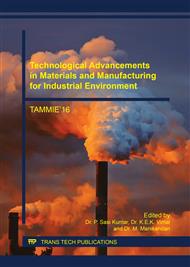p.41
p.48
p.58
p.64
p.73
p.81
p.88
p.97
p.105
Optimization of Material Removal Rate in Wire-EDM Using Fuzzy Logic and Artifical Neural Network
Abstract:
Present work aims to develop a model and optimize the material removal rate (MRR) in complex wire electric discharge machining (EDM) process. Initially various percentages of aluminium alloy hybrid Nanocomposites were fabricated by novel ultrasonication method. The sample specimens were cut and machined using wire EDM. Experiments were carried out using Taguchi’s L18 orthogonal array under different cutting parameters like Pulse-on, Pulse- off, current and servo voltage. Fuzzy-based Taguchi method and artificial neural network (ANN) with back propagation algorithm were used to optimize the material removal rate. Both ANN and fuzzy logic based models were developed in MATLAB software and the models were trained for estimating the MRR and improving the machining parameter.
Info:
Periodical:
Pages:
73-80
Citation:
Online since:
July 2017
Authors:
Keywords:
Price:
Сopyright:
© 2017 Trans Tech Publications Ltd. All Rights Reserved
Share:
Citation:


